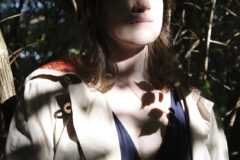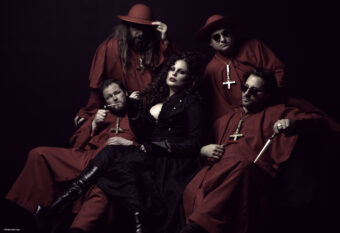Even when he’s not really trying, Hunter Hunt-Hendrix tends to deal in grandiose imagery. On one of those bitterly cold and unbearably bright late-January afternoons that occasionally peeks through New York City’s unrelenting gray, the 30-year-old frontman for Liturgy—a band of New York-based black-metal experimentalists—is sitting in front of the window in a mostly empty coffee shop near his Bushwick, Brooklyn apartment. At least, it seems to be him. He beckons from across the room, but the winter sunlight reflecting off snow through the glass reduces him to a blurry silhouette.
It’s an insignificant moment, maybe, but it’s a potent metaphor for the unpredictable records Hunt-Hendrix has made over the last half decade in conjunction with bassist Tyler Dusenbury, drummer Greg Fox, and guitarist Bernard Gann. Their music is meant to overwhelm and bombard. The torrents of Gann and Hunt-Hendrix’s tremolo-picked guitar lines warp and rupture, but they have to compete for attention with the unrelenting tumult of Fox’s roiling snare-drum, and the tortured grumbles of Dusenbury’s unconventional bass lines.
And Liturgy’s latest effort, the recently released The Ark Work, only doubles down on the overstimulation, throwing in a heavenly host of instruments that belie the group’s black-metal origins (glockenspiel, horns, and even bagpipes make cameos of varying significance). Hunt-Hendrix is zooming in on the experimental compositions that were previously relegated to just interludes and interstitials. And at the same time he’s embracing his long-held affections for Bone-Thugs-n-Harmony and, uh, Korn in an attempt to finally perform the impossible task of crafting a workable rap-metal hybrid. It’s a gleefully overstuffed work of pure ambition and hubris, and the resulting sensory experience is like staring straight into a solar eclipse — unequivocally beautiful, even if volatile and mystifying.
Blinding light behind him unacknowledged, Hunt-Hendrix quickly decides that it’s time to get heavy. Wearing a grimy brown hoodie and matching knit cap and sipping a cup of tea, he eschews most pleasantries and dives straight into the centuries of philosophical history and art movements that have spawned his band’s imposingly complex third album. Then, all of a sudden, he pauses, leans forward, and lays out his intents.
“Look,” he says, throwing furtive glances around the coffee shop and tucking his long hair back into his hat, “It’s a very fractured and confusing time. You can’t take religion seriously anymore. You can combine music and art and thought as a way to stand in for giving meaning to life — a total work of art.”
It’s a momentous claim to suggest that your creative undertaking can upend the way that a person relates to the world around them (and even more so considering that Hunt-Hendrix and I only met just moments before), but the singer-guitarist has never been the sort to shy away from big ideas, nor take half steps. He opens our conversation with the news that that he’s writing a new philosophical text to present at a forthcoming academic symposium on black metal. It’s a heady explication of a new extramusical course that Liturgy’s taken on in the wake of the successes — as well as the “painful and difficult” uproar— that surrounded their 2011 LP, Aesthethica.
https://youtube.com/watch?v=qciRxrlTFGc
Hunt-Hendrix lights up at the chance to talk about his new work — “not a manifesto,” he says, grinning — an exposition of his attempt to turn Liturgy into that life-affirming “total work of art.” What that means exactly, as with most ideas he engages with, is a bit complicated. On one hand, he says that the records are used as an important part of outlining a “cosmological system” that he’s developed with Liturgy, descendent maybe from the Wagnerian tradition of Gesamtkunstwerk. Fictional places and characters like Father Vorizen, Reign Array, and Kel Valhaal compose a vague, recurring mythology that exists mostly in the band’s song titles. But at the same time, Liturgy has moved far beyond being just about what’s contained on the records, unpredictable and orgiastic as they are.
“The band is a sculpture,” he explains. “Our career together is a drama. Angry bloggers from the metal scene who write mean comments are producing poetry that’s incorporated into the work. It’s kind of weird.”
He’s right: On the surface, it is kind of weird. He’s publishing lengthy philosophical texts and zines full of the caustic Internet comments and undertaking the meta-exercise of considering the group’s career arc as part of the overall artwork that he’s attempting to create. It’s ambitious and academic—and to the band’s detractors, totally over the top—but that’s been part of Liturgy from the beginning.
Hunt-Hendrix was born in New York City in 1985 into a family of “academics, therapists, psychologists, [and] theologians.” But after his mother introduced him to guitar at the age of five, he quickly took to dreams of rock‘n’roll stardom. “There was an expectation that I would be a professor,” he jokes, noting that a fascination with MTV, and consequently the Smashing Pumpkins’ Siamese Dream, was “a source of conflict.” But nevertheless, during cross-country moves to New Mexico (where he first took to Bone Thugs, as well as Tupac and N.W.A) and then back to New Jersey, he was still permitted to pursue his fledgling musical experiments. “I was just with my family and we watched footage of me performing at my birthday party at like age 8 in a gym, playing a Bon Jovi song,” he says, laughing.
Commuting from Jersey, Hunt-Hendrix attended middle school in the Bronx where he started playing music with future bandmate Fox after a meet-cute involving the latter’s Modern Drummer t-shirt. He describes their castoff early collaborations as “Smashing Pumpkins meets Cradle of Filth meets screamo,” but high school brought hardcore bands and a fixation on his father’s collection of abridged philosophical classics — a combination that eventually led to his enrollment at Columbia as a philosophy major and his initial forays into more outré experimentation.
At its inception, when Hunt-Hendrix was still an underclassman, Liturgy was just like any dorm-room music experiment. A previous black-metal band called the Return dissolved and Hunt-Hendrix took to the well-worn tradition of chunking out austere cassettes containing wiry guitar riffs and delirious snarling. They were genre exercises that only bear the most superficial similarities to the albums he’s making now. But even then, he was deep in the throes of his philosophical schooling and nursing a newfound interest in experimental music under the tutelage of noted spectral composer Tristan Murail. Those otherwise rudimentary tapes were constructed under the idea that the nascent Liturgy was “a band, but in quotation marks.” As he initially imagined it, the endeavor was something more like a performance-art project that just so happened to take the form of a careening metal band. It’s an idea that’s central to the project now more than ever.
But when the band ballooned into a four-piece for the first time, that idea was pushed to the background. Gann joined the band on guitar after hearing early Liturgy demos through a mutual friend and then developed what he called “musical responses,” frigid electronic drone pieces that would eventually play a role in the Liturgy live show. “We got along but I think we kept each other at arms length during those first few years,” Gann explains of his early friendship with Hunt-Hendrix. But soon after, they started playing together and it seemed to be an instant fit. Fox then joined as just one part of a series of his own manic post-collegiate musical efforts, bringing along his own occasional collaborator, Dusenbury to handle bass duties.
In 2009, things started to pick up for Hunt-Hendrix. With Liturgy, he released Renihilation, the first full-length to display the strangely mystic power of the band’s four-piece iteration. But at the same time, he wrote a text that remains the defining bit of his work for detractors of the band. It was, by all accounts a statement of intent. He called it a manifesto, festooned it with the title Transcendental Black Metal: A Vision of Apocalyptic Humanism, and later presented at an academic symposium about the typically dreary genre. The ten-page essay outlined an admittedly appropriative vision of black metal that’s in line with what you might expect from the high-minded title.
Hunt-Hendrix proposed a genre that takes black metal’s aggression and romanticism without the bleakness and nihilism. It’s black metal in its techniques, but it’s swooning and upwardly striving in its disposition. The way to move forward was to supplant the overwhelming gloominess of Scandinavian (or, as he called it, “Hyperborean”) black metal with a spirit of both “frenzy and ecstasy.” It would be a “specifically American joyful clamor.” He sought to shirk the layers of theater and convention — famously rejecting the requisite corpse paint — and get at the lively heart of the form he loved.
And then, in 2011, came the controversy. The band’s widely acclaimed Aesthethica hit record-store shelves, replete with head-spinning electronic interludes and Fox’s “burst beat” — a writhing, dynamic revision of the de rigueur blast beat. The album was a critical darling, a rare metal album to able to win over writers who wouldn’t usually touch the stuff. And with this newfound attention, a harsh new light was cast on the essay and Hunt-Hendrix’s ideas as a whole.
Though it lives on primarily as part of a textbook-length collection of the symposium’s presentations, the manifesto became infamous and its effects for Liturgy were inescapable. For its enterprise of intellectualizing the style and its unapologetically academic language, Transcendental Black Metal became a symbol for everything worth hating about a group of similarly minded black-metal deconstructionists. Bands like the shoegaze-flecked Deafheaven suffered their share of vitriol too. But because Hunt-Hendrix’ sins were explicitly philosophical instead of merely musical, he became something of a punching bag. Even today, if you head to the comments of a particularly infamous interview at Scion Rock Fest, angry commenters are still calling Hunt-Hendrix a “hipster,” a “douche,” and a slew of homophobic slurs. The band wasn’t immune to the criticism.
After a spate of live shows and rumors of another set with unusual tourmates Diplo and Sleigh Bells, Dusenbury and Fox left the band in September of 2011 to focus on other projects. Dusenbury in particular is quick to discredit the idea that “instances of interpersonal strife” were the main factor in the band’s three-year dissolution.
“A large part of my prior decision to leave Liturgy came from a general discomfort with the negativity surrounding the band’s reputation and image at that time,” Dusenbury explains. “The inevitable characterization of us as impostors, or dilettantes butting their heads into the old boy’s club of Kvlt Black Metal or whatever. People get worked up over silly shit.”
Hunt-Hendrix was also distressed about the way that people reacted to his ideas at the time. But dealing with both the painful response and the sudden departure of Dusenbury and Fox ended up allowing The Ark Work to crystalize.
“I wasn’t enjoying [the negative response] in 2011,” Hunt-Hendrix admits. “And yet I enjoy it too. I especially enjoy it now. Partially because [The Ark Work] sounds more the way that Liturgy is supposed to sound in my head. Who knows how it’ll be received, but I have this sigh of relief.”
After a string of festival dates in 2012, during which Liturgy had dwindled to just the duo of Hunt-Hendrix and Gann, the frontman moved back in with his parents in the Manhattan neighborhood of Morningside Heights. He hunkered down and began work on a Liturgy album that’d be distinct from what came before in some obvious musical ways (namely, the rap influences and disparate instrumental palette).
But soon, the album became what he calls the “clearest expression” of the musical ideas that he was trying to engage with on the records all along. Aesthethica introduced electronic interludes and overtone singing, experimental moments that functioned mostly as sidebars to the shrieking agitation of the more stereotypically metal tracks on the record. The Ark Work zooms in on those moments, expanding them to vertiginous lengths, including: trumpet-led chanting (on “Kel Valhaal”), a 13-minute proggy bagpipe epic (“Reign Array”), and Sleep-goes-footwork 808 freneticism (“Vitriol”), all while maintaining the vestiges of the genre that birthed the band.
Frankly, it’s a record that’s like little else that’s out there. It’s an alchemical stew of Hunt-Hendrix’s disparate musical fascinations (the dead-eyed grandeur of medieval sacred music, the unique catharsis of black metal, the witchy staccato chanting of a host of influential Southern rappers) all while being the most approachable Liturgy record to date. He takes existing structures and turns them into something alien, confounding, and distinctly his own.
Ever since the release of Aesthethica, Hunt-Hendrix has been talking about the role that rap would play in the new album. Undertaking what he saw as the “untouchable” task of marrying hip-hop to metal, he settled on the dark triplet flow of acts like Three Six Mafia as a possible bridge between the styles, eventually enacting a version of it on a number of the tracks on The Ark Work. Gone are Hunt-Hendrix’s idiosyncratic, throat-shredding snarls. And in its place are a series of monochromatic chants — resonant, as Hunt-Hendrix notes, with the “Migos flow” that rose to prominence while he was demoing the record, but still sonically distant from the exercise of putting the twerk in Gesamtkunstwerk. It’s hard not to read it as a reaction to his black-metal past, and to hear him tell it, it is that in part.
“Something about joining rap and black metal is a confrontation with the things that black metal has traditionally stood for that I want to distance myself from… like racism,” he explains, obliquely acknowledging the perverse ideologies of some of the genre’s founders and its occasional, despicable relationship with Nazism. “There should be some violence done to that.”
A couple of weeks after our first coffee shop meeting, Hunt-Hendrix is pacing around his apartment, a bright (if bare) respite from the sickly slush outside on an overcast February day. He shows me the spare room where he ended up finishing The Ark Work, a surprisingly austere space to conjure such a wealth of instrumental riches. Just four white walls, a keyboard setup, a guitar, and a computer. He excitedly points out the new midi guitar pickup that will allow him to translate this new material to a live setting, to trigger an assortment of horns, glockenspiel, organs, and glitchy manipulations all while still picking away (“Multitasking! It’s totally weird,” he says). For a moment, the philosopher veil drops and you can catch a glimpse of the kid who only ever just wanted to be on MTV. As ever, it’s about the joy of both the music and ideas for Hunt-Hendrix. He’ll remind you that both aspects come from the same place, but moments like this prove that you can’t easily dismiss one in favor of the other.
The timbre of our discussion here, again over tea, is mostly similar. Hunt-Hendrix talks passionately about the ideas behind Liturgy and generally seems less concerned in the mundane details of its construction, something that was reversed in ensuing discussions with Fox, Gann, and Dusenbury.
“I’m very deliberate in wanting to be a musician and also an artist and philosopher or something like that,” Hunt-Hendrix explains of the apparent disconnect. “I don’t think they see themselves as that way too.”
But he doesn’t necessarily see that as a detriment to the overall efforts of the band. He talks of the way that they keep him in check, mentioning that conversations with Dusenbury in particular kept him from including his latest manifesto within the liner notes of The Ark Work. “Personally, it seems more effective to drizzle a little elixir of wisdom on a melba toast, and people can take it or leave it,” Dusenbury says later. “If they want more, they can have a whole keg of elixir, or keep sampling melba toasts, or not. It’s an acquired taste.” Gann and Fox also exhibit varying degrees of engagement with Hunt-Hendrix’s philosophical ideas. While he find the ideas interesting and talks with Hunter about them on occasion, Gann says his “main concern is the music, the orchestration, performance, and sound.”
Hunt-Hendrix takes full ownership of the ideas and impulses of the band as a philosophical endeavor, but all of this suggests there’s still room for the guidance of those he keeps in his inner circle. I’m reminded of a moment earlier, when we were finishing up our discussion of the record’s rap influences. I mentioned to him that it might be possible to listen to his new vocal stylings and not immediately think of rap. He pondered that for a moment, drinks more tea, then let his unwavering academic confidence drop for just a moment.
“Would it be better if I didn’t talk about the reference points?” he asked. “I’ve had friends say, ‘Man you should just keep that quiet and just put out the music.'” I stumbled over my answer, surprised that after asserting ideas this big that he might be unsure of the way that he presents them. He continued before I had a chance to really solidify a thought, stating what’s become obvious after years of notorious verbosity and our own hours-long conversations.
“I could see that maybe,” he said, laughing. “But I just like talking about that stuff.”
All photos by Sam Clarke for SPIN.







